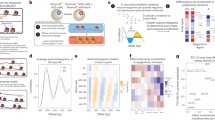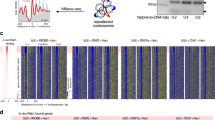Abstract
Arrays of regularly spaced nucleosomes directly correlate with closed chromatin structures at silenced loci. The ATP-dependent chromatin-assembly factor (ACF) generates such arrays in vitro and is required for transcriptional silencing in vivo. A key unresolved question is how ACF 'measures' equal spacing between nucleosomes. We show that ACF senses flanking DNA length and transduces length information in an ATP-dependent manner to regulate the rate of nucleosome movement. Using fluorescence resonance energy transfer to follow nucleosome movement, we find that ACF can rapidly sample DNA on either side of a nucleosome and moves the longer flanking DNA across the nucleosome faster than the shorter flanking DNA. This generates a dynamic equilibrium in which nucleosomes having equal DNA on either side accumulate. Our results indicate that ACF generates the characteristic 50- to 60-base-pair internucleosomal spacing in silent chromatin by kinetically discriminating against shorter linker DNAs.
This is a preview of subscription content, access via your institution
Access options
Subscribe to this journal
Receive 12 print issues and online access
$189.00 per year
only $15.75 per issue
Buy this article
- Purchase on Springer Link
- Instant access to full article PDF
Prices may be subject to local taxes which are calculated during checkout





Similar content being viewed by others
References
Huisinga, K.L., Brower-Toland, B. & Elgin, S.C. The contradictory definitions of heterochromatin: transcription and silencing. Chromosoma 115, 110–122 (2006).
Sun, F.L., Cuaycong, M.H. & Elgin, S.C. Long-range nucleosome ordering is associated with gene silencing in Drosophila melanogaster pericentric heterochromatin. Mol. Cell. Biol. 21, 2867–2879 (2001).
Fyodorov, D.V., Blower, M.D., Karpen, G.H. & Kadonaga, J.T. Acf1 confers unique activities to ACF/CHRAC and promotes the formation rather than disruption of chromatin in vivo. Genes Dev. 18, 170–183 (2004).
Ito, T., Bulger, M., Pazin, M.J., Kobayashi, R. & Kadonaga, J.T. ACF, an ISWI-containing and ATP-utilizing chromatin assembly and remodeling factor. Cell 90, 145–155 (1997).
Deuring, R. et al. The ISWI chromatin-remodeling protein is required for gene expression and the maintenance of higher order chromatin structure in vivo. Mol. Cell 5, 355–365 (2000).
Fazzio, T.G. et al. Widespread collaboration of Isw2 and Sin3-Rpd3 chromatin remodeling complexes in transcriptional repression. Mol. Cell. Biol. 21, 6450–6460 (2001).
Goldmark, J.P., Fazzio, T.G., Estep, P.W., Church, G.M. & Tsukiyama, T. The Isw2 chromatin remodeling complex represses early meiotic genes upon recruitment by Ume6p. Cell 103, 423–433 (2000).
Kang, J.G., Hamiche, A. & Wu, C. GAL4 directs nucleosome sliding induced by NURF. EMBO J. 21, 1406–1413 (2002).
Mizuguchi, G., Tsukiyama, T., Wisniewski, J. & Wu, C. Role of nucleosome remodeling factor NURF in transcriptional activation of chromatin. Mol. Cell 1, 141–150 (1997).
Hamiche, A., Sandaltzopoulos, R., Gdula, D.A. & Wu, C. ATP-dependent histone octamer sliding mediated by the chromatin remodeling complex NURF. Cell 97, 833–842 (1999).
Eberharter, A. et al. Acf1, the largest subunit of CHRAC, regulates ISWI-induced nucleosome remodeling. EMBO J. 20, 3781–3788 (2001).
Langst, G., Bonte, E.J., Corona, D.F. & Becker, P.B. Nucleosome movement by CHRAC and ISWI without disruption or trans-displacement of the histone octamer. Cell 97, 843–852 (1999).
Tsukiyama, T., Palmer, J., Landel, C.C., Shiloach, J. & Wu, C. Characterization of the imitation switch subfamily of ATP-dependent chromatin-remodeling factors in Saccharomyces cerevisiae. Genes Dev. 13, 686–697 (1999).
Varga-Weisz, P.D. et al. Chromatin-remodeling factor CHRAC contains the ATPases ISWI and topoisomerase II. Nature 388, 598–602 (1997).
Corona, D.F. et al. ISWI is an ATP-dependent nucleosome remodeling factor. Mol. Cell 3, 239–245 (1999).
Poot, R.A. et al. HuCHRAC, a human ISWI chromatin remodeling complex contains hACF1 and two novel histone-fold proteins. EMBO J. 19, 3377–3387 (2000).
LeRoy, G., Orphanides, G., Lane, W.S. & Reinberg, D. Requirement of RSF and FACT for transcription of chromatin templates in vitro. Science 282, 1900–1904 (1998).
Fan, H.Y., He, X., Kingston, R.E. & Narlikar, G.J. Distinct strategies to make nucleosomal DNA accessible. Mol. Cell 11, 1311–1322 (2003).
Bochar, D.A. et al. A family of chromatin remodeling factors related to Williams syndrome transcription factor. Proc. Natl. Acad. Sci. USA 97, 1038–1043 (2000).
Stockdale, C., Flaus, A., Ferreira, H. & Owen-Hughes, T. Analysis of nucleosome repositioning by yeast ISWI and Chd1 chromatin remodeling complexes. J. Biol. Chem. 281, 16279–16288 (2006).
He, X., Narlikar, G.J., Fan, H.Y. & Kingston, R.E. HAcf1 alters the remodeling strategy of SNF2H. J. Biol. Chem. 281, 28636–28647 (2006).
Ito, T. et al. ACF consists of two subunits, Acf1 and ISWI, that function cooperatively in the ATP-dependent catalysis of chromatin assembly. Genes Dev. 13, 1529–1539 (1999).
Lowary, P.T. & Widom, J. New DNA sequence rules for high affinity binding to histone octamer and sequence-directed nucleosome positioning. J. Mol. Biol. 276, 19–42 (1998).
Wolffe, A.P. & Hayes, J.J. Transcription factor interaction with model nucleosomal templates. Methods Mol. Genet. 2, 314–330 (1993).
Lohman, T.M., Thorn, K. & Vale, R.D. Staying on track: common features of DNA helicases and microtubule motors. Cell 93, 9–12 (1998).
Schwanbeck, R., Xiao, H. & Wu, C. Spatial contacts and nucleosome step movements induced by the NURF chromatin remodeling complex. J. Biol. Chem. 279, 39933–39941 (2004).
Zofall, M., Persinger, J., Kassabov, S.R. & Bartholomew, B. Chromatin remodeling by ISW2 and SWI/SNF requires DNA translocation inside the nucleosome. Nat. Struct. Mol. Biol. 13, 339–346 (2006).
Strohner, R. et al. A 'loop recapture' mechanism for ACF-dependent nucleosome remodeling. Nat. Struct. Mol. Biol. 12, 683–690 (2005).
Kagalwala, M.N., Glaus, B.J., Dang, W., Zofall, M. & Bartholomew, B. Topography of the ISW2-nucleosome complex: insights into nucleosome spacing and chromatin remodeling. EMBO J. 23, 2092–2104 (2004).
Langst, G. & Becker, P.B. ISWI induces nucleosome sliding on nicked DNA. Mol. Cell 8, 1085–1092 (2001).
Fazzio, T.G. & Tsukiyama, T. Chromatin remodeling in vivo: evidence for a nucleosome sliding mechanism. Mol. Cell 12, 1333–1340 (2003).
Zofall, M., Persinger, J. & Bartholomew, B. Functional role of extranucleosomal DNA and the entry site of the nucleosome in chromatin remodeling by ISW2. Mol. Cell. Biol. 24, 10047–10057 (2004).
Whitehouse, I., Stockdale, C., Flaus, A., Szczelkun, M.D. & Owen-Hughes, T. Evidence for DNA translocation by the ISWI chromatin-remodeling enzyme. Mol. Cell. Biol. 23, 1935–1945 (2003).
Saha, A., Wittmeyer, J. & Cairns, B.R. Chromatin remodeling by RSC involves ATP-dependent DNA translocation. Genes Dev. 16, 2120–2134 (2002).
Amitani, I., Baskin, R.J. & Kowalczykowski, S.C. Visualization of Rad54, a chromatin remodeling protein, translocating on single DNA molecules. Mol. Cell 23, 143–148 (2006).
Lia, G. et al. Direct observation of DNA distortion by the RSC complex. Mol. Cell 21, 417–425 (2006).
Segal, E. et al. A genomic code for nucleosome positioning. Nature 442, 772–778 (2006).
Whitehouse, I. & Tsukiyama, T. Antagonistic forces that position nucleosomes in vivo. Nat. Struct. Mol. Biol. 13, 633–640 (2006).
Flaus, A. & Owen-Hughes, T. Dynamic properties of nucleosomes during thermal and ATP-driven mobilization. Mol. Cell. Biol. 23, 7767–7779 (2003).
Levenstein, M.E. & Kadonaga, J.T. Biochemical analysis of chromatin containing recombinant Drosophila core histones. J. Biol. Chem. 277, 8749–8754 (2002).
Aalfs, J.D., Narlikar, G.J. & Kingston, R.E. Functional differences between the human ATP-dependent nucleosome remodeling proteins BRG1 and SNF2H. J. Biol. Chem. 276, 34270–34278 (2001).
Luger, K., Rechsteiner, T.J. & Richmond, T.J. Preparation of nucleosome core particle from recombinant histones. Methods Enzymol. 304, 3–19 (1999).
Davey, C.A., Sargent, D.F., Luger, K., Maeder, A.W. & Richmond, T.J. Solvent mediated interactions in the structure of the nucleosome core particle at 1.9 Å resolution. J. Mol. Biol. 319, 1097–1113 (2002).
Mukhopadhyay, J. et al. Translocation of sigma(70) with RNA polymerase during transcription: fluorescence resonance energy transfer assay for movement relative to DNA. Cell 106, 453–463 (2001).
Narlikar, G.J., Phelan, M.L. & Kingston, R.E. Generation and interconversion of multiple distinct nucleosomal states as a mechanism for catalyzing chromatin fluidity. Mol. Cell 8, 1219–1230 (2001).
Acknowledgements
We thank J. Widom (Northwestern University) for the 601 plasmid, J.J. Hayes (University of Rochester Medical Center) for the 5S plasmid, H.-Y. Fan and R.E. Kingston (Harvard Medical School) for SNF2h and ACF1 constructs, R.D. Mullins (University of California, San Francisco) for use of the fluorometer, K. Ashrafi, H.-Y. Fan, J.T. Kadonaga, B. Panning, A.K. Srivastava, J.S. Weissman, J. Widom, C. Wu and K.R. Yamamoto for helpful comments on the manuscript and members of the Narlikar lab for technical advice and discussion. J.G.Y. is supported by a US National Science Foundation Graduate Research Fellowship. This work was supported in part by a grant from the US National Institutes of Health (to G.J.N.).
Author information
Authors and Affiliations
Contributions
J.G.Y., T.S.M. and G.J.N. designed the experiments, J.G.Y. and T.S.M. did the experiments and analyzed the data, E.S. made reagents for the experiments and J.G.Y. and G.J.N. interpreted the data and wrote the manuscript.
Corresponding author
Ethics declarations
Competing interests
The authors declare no competing financial interests.
Supplementary information
Supplementary Fig. 1
Mapping histone octamer positions of mononucleosome substrates. (PDF 688 kb)
Supplementary Fig. 2
An alternative model for hACF centering. (PDF 175 kb)
Supplementary Fig. 3
Modeling mononucleosome centering by hACF. (PDF 389 kb)
Supplementary Fig. 4
Kinetics of remodeling at 2 mM ATP. (PDF 88 kb)
Supplementary Fig. 5
hACF remodeling is sequence independent. (PDF 167 kb)
Supplementary Fig. 6
hACF activity on 601 nucleosomes with varying flanking DNA lengths. (PDF 287 kb)
Supplementary Fig. 7
Restriction enzyme accessibility experiment. (PDF 68 kb)
Supplementary Fig. 8
Model for centering assuming hACF is a dimer. (PDF 71 kb)
Rights and permissions
About this article
Cite this article
Yang, J., Madrid, T., Sevastopoulos, E. et al. The chromatin-remodeling enzyme ACF is an ATP-dependent DNA length sensor that regulates nucleosome spacing. Nat Struct Mol Biol 13, 1078–1083 (2006). https://doi.org/10.1038/nsmb1170
Received:
Accepted:
Published:
Issue Date:
DOI: https://doi.org/10.1038/nsmb1170
This article is cited by
-
Energy-driven genome regulation by ATP-dependent chromatin remodellers
Nature Reviews Molecular Cell Biology (2023)
-
Nucleosome density shapes kilobase-scale regulation by a mammalian chromatin remodeler
Nature Structural & Molecular Biology (2023)
-
Single-Molecule Characterization of Cy3.5 -Cy5.5 Dye Pair for FRET Studies of Nucleic Acids and Nucleosomes
Journal of Fluorescence (2023)
-
BANP opens chromatin and activates CpG-island-regulated genes
Nature (2021)
-
Ruler elements in chromatin remodelers set nucleosome array spacing and phasing
Nature Communications (2021)



